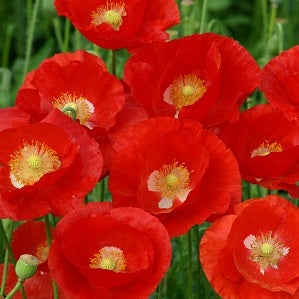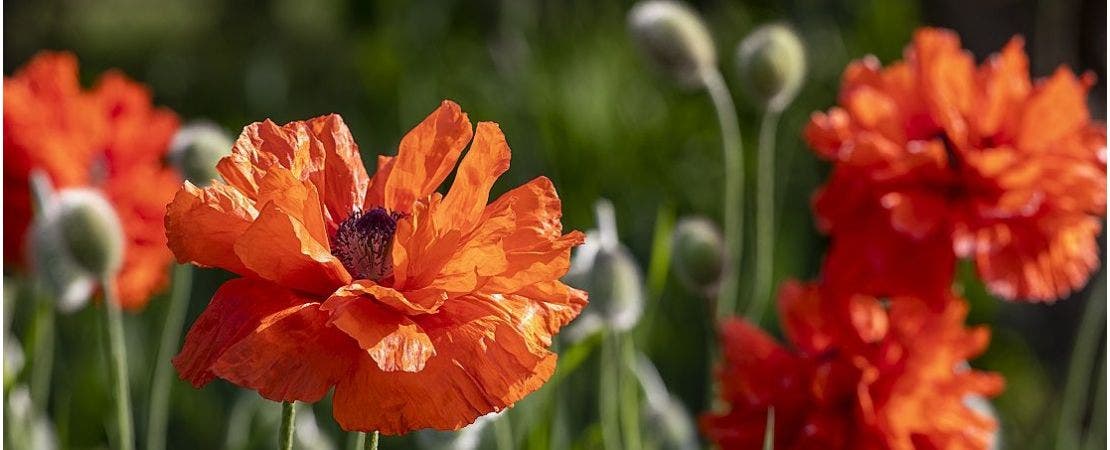Why are Poppies Symbolic of Veteran’s Day?
Veteran’s Day is the holiday kept on the day that officially ended the First World War. The Armistice between Germany and the Allies, Great Britain, France, Italy, Japan, and the United States, went into effect on “the 11th hour of the 11th day of the 11th month" of 1918. Known at the time as Armistice Day, today it is called Remembrance Day in Commonwealth and Veterans’ Day in the United States.
The First World War caused horrific casualties. It Is estimated that 20 million soldiers and civilians died and another 23 million in the military were wounded. People, appalled, vowed never to forget the sacrifices.
How did poppies get involved? The common poppy, Papaver rhoeas, in the poppy family, Papaveraceae, is a short (to 18”) red-flowered poppy of Europe. Also called the corn poppy and field poppy, it is an annual plant that grows well in disturbed sites, frequently showing up in and around agricultural fields. The trench battles of World War I tore up the countryside in northwestern France (Normandy), and neighboring Belgium, the region called Flanders. The burial of thousands and thousands of soldiers further disturbed the soil. For common poppies, this provided good conditions for seed germination. Observers had reported red poppies on European battlefields from before 1600, but the devastation of World War I battle sites and cemeteries was far more extensive. Furthermore, modern warfare added a lot of lime to the soil, making it too alkaline for most plants--but not common poppies. So the countryside of France and Belgium turned into a carpet of red; scarlet poppies as far as the eye could see.
That would have been largely forgotten, since it was a time before selfies or even color photographs, except for a poem and two dedicated women.
Lieutenant-Colonel John McCrae, surgeon with Canada’s First Brigade Artillery, scribbled a poem when, in on May 3, 1915, after the Battle of Ypres, he buried his close friend Alexis Helmer.


In Flanders Fields
In Flanders Fields, the poppies blow
Between the crosses, row on row,
That mark our place; and in the sky
The larks, still bravely singing, fly
Scarce heard amid the guns below.
We are the dead. Short days ago
We lived, felt dawn, saw sunset glow,
Loved and were loved, and now we lie,
In Flanders fields.
Take up our quarrel with the foe:
To you from failing hands we throw
The torch; be yours to hold it high.
If ye break faith with us who die
We shall not sleep, though poppies grow
In Flanders fields.
The poem resonated with the men to whom McCrea first showed it—one immediately memorized it. McCrea published the poem in the British magazine Punch in December, 1915.
That might have been the end of the story, except for the efforts of two women. Professor Moina Michael, on leave from the University of Georgia, was volunteering in Europe with the American YMCA when she read it. She loved the poem and, inspired, promoted the common poppy. Wear poppies as a symbol of remembrance, and of dedication to ongoing support of soldiers, veterans, and the fallen. Because common poppies are not in flower in November, the remembrance poppy was from the beginning an artificial copy of a red poppy. In 1918 Michael attended a YMCA Overseas War Secretaries conference wearing her red silk poppy and handed out twenty-five more. She launched a campaign that the common poppy, by now called the Flanders poppy, become the American national symbol of remembrance.
Meanwhile, Frenchwoman Madame Anna Alix Boulle Guérin spent the years of the First World War in the United States raising money for the war effort. She was an outstanding speaker and effective fund-raiser. Immediately after the Armistice, the French government asked her to lead a campaign to collect for war orphans, with the red poppy as its symbol. They, too, were inspired by McCrea’s poem. Guérin spent 1919 traveling the U.S., exchanging red paper poppies for donations, part of her vision of an international Inter-Allies Poppy Day of commemoration. She and Michael appear to have worked separately for the same goal. In September 1920, Guérin addressed the American Legion conference and Legion was inspired by the “French poppy lady” to adopt the Flanders poppy as their memorial emblem. Guérin then carried her campaign back to Europe. In 1921 the British Legion adopted it for countries within the British Empire and her allies.
In the 100 years since, there have of course been controversies, over which veterans group should use the poppy as their symbol, over who else should use it, over using the remembrance poppy to pressure people to support causes they did not support, the typical controversies successful symbols attract.
The red poppy continues to be worn, in paper or cloth, designed to exactly replicate a real common poppy, in remembrance of war dead and their sacrifices. It is especially important in the United Kingdom, Canada, Australia, and New Zealand, but it is widely seen in the United States as well, both at Memorial Day in May and Veterans Day in November. Usually, it is exchanged for a donation to deceased or injured veterans. Subsequent wars, World War II in particular, have broadened the conflicts which the red poppy commemorates and the range of veterans it supports. It remains a well-known symbol honoring the sacrifices of the military.
If you want to grow Flanders poppies, roll heavy wagons all over your property, dig trenches, and spill gunpowder….of course that isn’t necessary! Papaver rhoeas likes full sun, will grow in well-drained soils from acidic to alkaline (it was the other plants that wouldn’t grow in Flanders’ fields), and grows in pretty much any climate (USDA Zones 1-10). They are beautiful in the garden and make fine cut flowers.
Kathy Keeler, A Wandering Botanist





